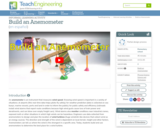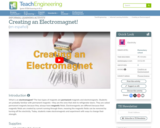
Learn to build a small habitat for the Moon.
- Subject:
- Astronomy
- Science
- Material Type:
- Activity/Lab
- Provider:
- NASA
- Provider Set:
- STEM Outreach
- Author:
- NASA
- National Aeronautics and Space Administration
- Date Added:
- 06/08/2023

Learn to build a small habitat for the Moon.

If you build it carefully, this crazy contraption demonstrates one of the basic laws of nature.

Learn shapes and build rockets with paper cut out activity sheets

Working as if they are engineers who work for (the hypothetical) Build-a-Toy Workshop company, students apply their imaginations and the engineering design process to design and build prototype toys with moving parts. They set up electric circuits using batteries, wire and motors. They create plans for project material expenses to meet a budget.

A game where players use blueprints to build a fleet of rockets by dragging and dropping pieces into the correct spots.

Students create their own anemometers instruments for measuring wind speed. They see how an anemometer measures wind speed by taking measurements at various school locations. They also learn about different types of anemometers, real-world applications, and how wind speed information helps engineers decide where to place wind turbines.

Students build anemometers and use them to calculate wind speed.

Students create models of objects of their choice, giving them skills and practice in techniques used by professionals. They make sketches as they build their objects. This activity facilitates a discussion on models and their usefulness.

Build an atom out of protons, neutrons, and electrons, and see how the element, charge, and mass change. Then play a game to test your ideas!

Students build miniature model cities using sugar, bouillon and gelatin cubes. The cities are put through simulated earthquakes to see which cube structures withstand the shaking movements the best.

Students build electromagnets and use them to pick up objects.

This is an activity about the moon. Learners will create their own models of lunar orbiters out of edible or non-edible materials. They determine what tools would be necessary to help us better understand the Moon and plan for a future lunar outpost. Then they incorporate these elements into their models. NASA's Lunar Reconnaissance Orbiter is used as an example of a spacecraft armed with "eyes," "ears," and other tools for exploration. This activity is part of Explore! To the Moon and Beyond! - a resource developed specifically for use in libraries.

Student groups construct simple conductivity probes and then integrate them into two different circuits to test the probe behavior in solutions of varying conductivity (salt water, sugar water, distilled water, tap water). The activity culminates with student-designed experiments that utilize the constructed probes. The focus is to introduce students to the fabrication of the probe and expose them to two different ways to integrate the probe to obtain qualitative and quantitative measurements, while considering the application and utility of a conductivity probe within an engineering context. A provided handout guides teams through the process: background reading and questions; probe fabrication including soldering; probe testing and data gathering (including circuit creation on breadboard); probe connection to Arduino (including circuit creation and code entry) and a second round of testing and data gathering; design and conduct their own lab experiments that use the probes; online electrolyte/nonelectrolyte reading, short video, comprehension check and analysis questions.

Students learn about atoms and their structure (protons, electrons, neutrons) — the building blocks of matter. They see how scientific discoveries about atoms and molecules influence new technologies developed by engineers.

Students build their own small-scale model roller coasters using pipe insulation and marbles, and then analyze them using physics principles learned in the associated lesson. They examine conversions between kinetic and potential energy and frictional effects to design roller coasters that are completely driven by gravity. A class competition using different marbles types to represent different passenger loads determines the most innovative and successful roller coasters.

The city of Fort Collins, Colorado, found a win-win solution to problems it faced with 100 acres of abandoned property. The city now enjoys new green space, improved floodwater management, and a boosted economy.

Working in teams of four, students build tetrahedral kites following specific instructions and using specific materials. They use the basic processes of manufacturing systems – cutting, shaping, forming, conditioning, assembling, joining, finishing, and quality control – to manufacture complete tetrahedral kites within a given time frame. Project evaluation takes into account team efficiency and the quality of the finished product.

Students investigate the weather from a systems approach, learning how individual parts of a system work together to create a final product. Students learn how a barometer works to measure the Earth's air pressure by building a model using simple materials. Students analyze the changes in barometer measurements over time and compare those to actual weather conditions. They learn how to use a barometer to understand air pressure and predict actual weather changes.

This is an lesson about spectrographs. Learners will build and decorate their own spectrographs using simple materials and holographic diffraction gratings. After building the spectrographs, they observe the spectra of different light sources. Requires advance preparation to spray-paint the inside of the containers black the day before construction. The activity is part of Project Spectra, a science and engineering program for middle-high school students, focusing on how light is used to explore the Solar System.

Students create and decorate their own spectrographs using simple materials and holographic diffraction gratings. A holographic diffraction grating acts like a prism, showing the visual components of light. After building the spectrographs, students observe the spectra of different light sources as homework.